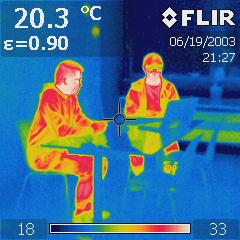Innovations that leverage new technologies are creating new products and services (and a few billionaires) while disrupting industries as diverse as transportation, retail and hospitality. However, with the exception of some promising startups, the commercial building sector has been a laggard with respect to data science innovation. This spring, the research team at the Center for the Built Environment (CBE), in collaboration with other researchers and industrial partners, will launch two projects to develop new ways to gather, analyze and monetize data from commercial buildings, yielding energy cost savings and more comfort for building users.
The work will be funded through two projects recently selected by the U.S. Department of Energy (DOE) Building Technologies Office. Support for these cross-cutting R&D projects includes $2.5M from DOE, and approximately $575K in match funding, including funds from CBE’s Industry Partners. This research will be conducted over a period of three years, with team members from the Lawrence Berkeley National Lab (LBNL) and several building technology companies as noted below.
New Open-Source Tools for Building Analytics, Modeling and Controls
The large amount of data generated by building automation systems (BAS) can provide insights into building operations, but few resources are available to help operators strive beyond immediate operational concerns. The goal of this project “Skewering the Silos: Using Brick to Enable Portable Analytics, Modeling, and Control,” is to develop a lightweight schema for representing this data, as well as tools and incentives so that they can quickly and cost-effectively analyze BAS data to make large energy cost savings, relying only on software solutions.
The work will advance “Brick,” an open-source metadata schema for buildings. Brick software models will enable the scaling of methods leading to major energy savings, improved building performance, and grid responsiveness across commercial buildings at low cost. CBE researcher Paul Raftery, co-principal investigator for the project, explains that Brick can be used to identify various building elements — and store information about how they relate to one another — for example, a thermostat, a space,a VAV box and the associated air handling unit. “Operators have access to BAS data, but in general that data is not being used. With Brick, an operator could include some of the data in the Brick model, and quickly apply an open-source analytics application to quickly find useful insights or directly control devices. For example, they could identify all zones where temperatures frequently exceed setpoints.” As operators add more information to the Brick model, they will be able to take advantage of more open-source applications.
A near-term goal will be energy savings in existing buildings, as broad and cost-effective energy savings are needed to mitigate the growing threat of climate change. To this end, project deliverables include an open source analytics library for energy savings and for fault detection without requiring a full retro-commissioning process (although Brick may be valuable for commissioning also).
The longer-term goals of this project are to enable synergies throughout the project delivery process, during design with building information and energy modeling programs, to sensing and building control operation. To speed adoption, the team is working with the ASHRAE BACnet committee and Project Haystack to incorporate Brick as part of ASHRAE Standard 223P, a new proposed standard for semantic tagging of building data. UC Berkeley team members include Therese Peffer, Gabe Fierro, Paul Raftery and Greg Thomson, along with researchers from LBNL and Johnson Controls International. This project was funded as part of DOE’s Building Energy Efficiency Frontiers & Innovation Technologies (BENEFIT) program.
Using Infrared Thermography for Occupant-Centric Building Control
The idea of including occupants in the real-time control of buildings to improve both energy efficiency and comfort has been a focus of previous CBE research, and was the core concept behind the successful ‘proptech’ startup Comfy, recently acquired by Siemens. A second new DOE award will support the development of new methods to use occupant biometric data to improve the operation of commercial building HVAC operations.

CBE will use thermal infrared imaging and other methods to create occupant-centric HVAC control.
Previous research by CBE and others shows that the overcooling common in buildings uses excessive energy and causes discomfort. This project will use automatic detection of occupants’ comfort (in addition to sensing presence) to create a real-time feedback loop in HVAC operation, thereby saving energy and improving comfort. The project will infer occupants’ thermal comfort through visual and thermal infrared imaging of faces and hands using a new ceiling-mounted sensor that be developed in the initial phase of the project. This work builds on CBE’s previous research demonstrating that skin temperature measurements correlate well with overall thermal comfort and using machine learning to predict thermal comfort from infrared thermography.
The project will include field-testing of the sensor assembly and developing comfort prediction logic and HVAC control algorithms. This technology is expected to decrease commercial building overcooling by at least 50 percent, with a payback of one to two years in a warm climate. This work will be led by Ronnen Levinson of LBNL, with CBE’s Edward Arens, Ali Ghahramani, and principal investigator Hui Zhang. Industry collaborators include CBE partner Daikin U.S. and MoviTHERM a manufacturer of thermal imaging products.

